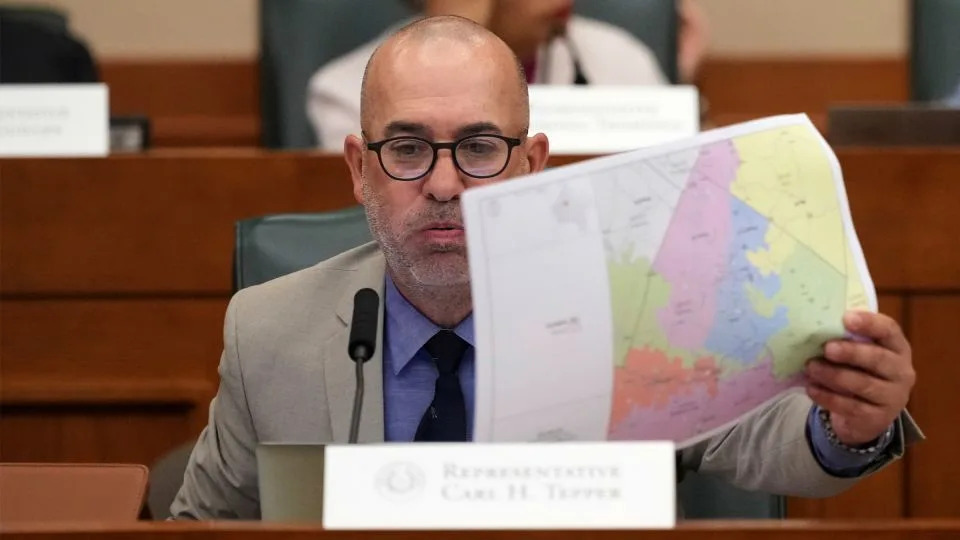
Texas Republicans are apparently going big with their brazen attempt to redraw the state’s congressional maps in the middle of the decade, outside of the normal redistricting process.
A draft map released Wednesday would add three new districts that would have voted for President Donald Trump in 2024. That would mean 79% of the state’s districts (30 out of 38) would have backed the president compared to his 56% share of the vote in the state.
It would also put two House Democrats who won Trump districts in significantly more danger in 2026.
The proposed map is intended to help the GOP hold on to the House — where they have a historically narrow majority and history suggests Democrats are very likely to pick up seats — in the midterm elections. The map could help Republicans flip five seats, significantly raising the bar for a Democratic takeover of the chamber.
All of which has set off a predictable round of whataboutism on the right. Yes, Texas Republicans are going for the bare knuckles on this one. But what about all those egregious Democratic gerrymanders? Both sides play this game, right?
Yes, both sides gerrymander. But that doesn’t mean they are equal-opportunity offenders.
Republicans pretty clearly benefit more from gerrymandering, and there’s an increasingly strong case to be made that they go further in using the tools available to them. Gambits like what Texas is doing are rare, and it’s been Republicans who have led the charge.
But this is the subject of plenty of debate, and there’s a school of thought that gerrymandering has become effectively a wash.
Some analysts point to recent election results that show the percentage of House seats each side wins these days more or less matches their share of the nationwide popular vote for the House.
Republicans, for example, won about 51.3% of the two-party vote in 2024. And 51.3% of House districts is about 223 seats. They won 220 seats.
In fact, these numbers have tracked closely over the last four elections. While there was just a three-seat gap in 2024, it was only two seats in each of the previous three elections. Neither side is winning a significantly disproportionate number of seats.
But just because the seat totals so closely mirror the overall vote shares doesn’t necessarily mean gerrymandering didn’t have an impact – or that one side or the other didn’t go to more extremes to try and secure the seats they won.
The ways in which populations are distributed matters greatly, for instance – particularly if one side’s voters are a lot more concentrated. Just because a state is competitive doesn’t mean that a “fair” map would be a 50-50 one. Generally speaking, “fair” districts are thought to group people with similar interests or backgrounds, and respect existing geographic boundaries. Sometimes in order to get that 50-50 split or even a narrow advantage for your side, you have to get pretty creative.
In addition, gerrymandering can be a risky game. A really extreme gerrymander could backfire if your effort to create as many favorable districts as possible spreads your voters too thin and you wind up losing seats. (Some have wagered this could happen to Republicans in Texas, particularly if the GOP can’t replicate Trump’s big 2024 gains with Hispanic voters.)
If the results of that gerrymander weren’t as lopsided as envisioned, does it really mean it wasn’t an extreme gerrymander?
This reinforces why you can’t just look at seat totals and vote shares. You really need to look at individual maps and how aggressively they’re drawn. This is, of course, a somewhat subjective exercise that depends on what factors you look at. But some experts have attempted to do that.
The Gerrymandering Project at Princeton University, which evaluates the maps holistically, gives a “D” or an “F” rating to slight majorities of maps drawn by Republicans and those drawn by Democrats.
PlanScore, spearheaded by well-known academics, finds that more maps have a bias toward Republicans than Democrats across a number of metrics.
These PlanScore numbers, too, come with caveats.
One is that, in about half of states, the map-drawing process wasn’t fully controlled by one party or another – either because the state has split legislative control, or because courts or redistricting commissions do it. So even if more maps favor Republicans, it’s not just because they drew them that way.
The second is that a big reason more maps appear to have a GOP bias is that Republicans simply get more opportunities to gerrymander. They have full control of more states because they hold the “trifecta” of the governor’s mansion and both chambers of the state legislature. In the most recent round of post-Census redistricting, Republicans controlled the drawing of 177 districts (estimates on this vary slightly), compared to just 49 for Democrats, according to a 2022 report from the left-leaning Brennan Center for Justice at New York University’s law school.
(Part of the reason Republicans have more control is their superior standing in state governments and the fact that blue states have been more likely to outsource this process to redistricting commissions.)
The Brennan Center has also noted that Republicans appear to benefit from state courts having a more laissez-faire approach to partisan gerrymandering.
All told, the center found 11 Republican-drawn maps that had extreme partisan bias, compared to four drawn by Democrats, ahead of the 2024 elections.
Which brings us to the latest developments. They certainly reinforce the idea that Republicans are more ruthless about using this power.
The reason Texas is so controversial isn’t just that Republicans are drawing such a slanted map; it’s mostly when they have chosen to do it – in the middle of the decade, outside the normal post-Census redistricting process.
Maps are sometimes redrawn after that post-Census period, but usually it’s because courts force states to do so. When state legislatures have done this of their own volition, it’s been Republicans in charge.
Depending on how you slice it, we’ve seen three or four modern attempts like this at mid-decade redistricting.
The GOP did this in Texas and Colorado in 2003 (though the Colorado map was struck down) and in Georgia in 2005. They also redrew the maps in North Carolina in 2023 after a newly conservative-leaning state Supreme Court reversed an earlier decision and opened the door to partisan gerrymandering.
State legislative expert Tim Storey told the Washington Post back in 2003 that the strategy appeared unprecedented at the time.
And while Democrats are talking about a tit-for-tat in which they would do the same thing in states like California and New York, that would be a response to the GOP’s own gambit. Not to mention, Democrats would also face major legal and political hurdles in these states to make that a reality.
Indeed, Republicans seem to be leaning in on a mid-decade redistricting arms race, knowing they have superior capabilities and can take things further — just like they have before.
For more CNN news and newsletters create an account at CNN.com








Comments